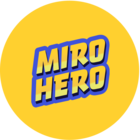Hi Miro Heroes
Anna here, your Community Manager.
This March, we are celebrating Women’s History Month by hosting a special edition Miroverse Challenge, Womxn at Work, and highlighting the most inspiring female creators that contributed templates to our template library.
I’m super excited to share our conversation with Amy Hartman, Writers’ Assistant based in Los Angeles, California. Amy worked on many well-known TV shows such as Mr. Robot, Star Trek: Picard, and Motherland: Fort Salem. She also created a super useful Miroverse template for screenwriters — Episode White Board for TV Writer's Rooms.
We sat down with Amy to talk about her career path and get some tips & tricks for aspiring Miroverse Creators.
TL;DR:
-
How TV writers can use Miro for remote collaboration: We have one big whiteboard with episode numbers across the top, character names down the side, and then we add stickies outlining what each character's doing in every episode; being able to see the whole thing is really useful. When you have this visibility into the season or an episode, you can see where the gaps are.
-
Advice for aspiring writers: You want things to be hard for your characters or else there's no drama; it's a lot harder to write that way, but your writing becomes a lot better because your characters have to be smarter and they have to try harder which makes everybody like them more.
-
How to stay consistent when working with a big creative team: It can be hard, especially when you are just starting to work on a big project; good leaders keep the guardrails and act as curators so the final product is consistent — after this initial period is over, it’s easier to collaborate because you understand the tone of the story much better.
Want to continue the conversation?
-
If you have a question for Amy about creative writing, team collaboration, or Miroverse, add it to the thread below. She will answer all of your questions asynchronously.
-
If you have a favorite template for storytellers (either from Miroverse or your own), post it in the thread as well!
Full Q&A with Amy Hartman
What’s your background? How did you start working as a Writer’s Assistant?
I've spent the last several years working various support staff roles in television writers' rooms. At first, I worked as a show's assistant, which is more admin focused. For the last several years, I've been a writer's assistant. For each TV show, there is a big group of writers working on it. You break the season into episodes together and then different people are assigned different scripts. Especially when there was only broadcast TV, you would have 24 episodes a season, and one person could never write all of that.
The writer's assistant job is to take notes on everything. You're listening all day every day, you have to keep track of everything. In a lot of ways, you have to be the encyclopedia of everything that's happened in the writing room. It’s important because as you get closer to production or prep, or if you are filming while you're writing, showrunners are not around because they have a million other things they're doing, so you make sure nothing is lost.
I really like this job. It's a lot of fun. In most rooms, you can also participate, pitch ideas, be a part of the discussion.
How does this collaboration work? Is there a specific process that you usually go through to create a script?
Every room is different. It all depends on how big your room is, what your show is, or who your showrunner is. Comedy rooms tend to be bigger than drama rooms because you need more people who can crank jokes.
Speaking of the process, it all starts when the showrunner has an idea. They write a pilot and then they hire a writer's room. Ideally, the showrunner will have a good idea of where the first season is going and knows how the season is going to end. Imagine we have 10-13 episodes, so the writers try to loosely figure out what's gonna happen in each of them. When you figure out who the main characters are, it’s important to track their stories throughout the season. And it is an extremely creative and collaborative process — everyone is just pitching ideas until something starts to stick. And at the end of the day, the showrunner decides what they like best and then that would go to the network and they'll have notes that we incorporate. When you have a big picture for the whole season, we'll start getting into each episode and break it into scenes, and writers go and finalize the scripts.
What are your top highlights from working on Mr. Robot?
While working on the last season, our showrunner had a clear idea about things that he wanted to happen, but he was open about the way they happened. We'd spent a week on one idea for the finale, but then we got stuck because it never really worked. I had an idea for a different direction and I decided to pitch it.
It landed, which was really awesome! That's why we do this — coming up with the idea that people go for is very gratifying.
When we imagine a writer's room, it's a really interesting mix between team collaboration and executing on a showrunner's vision. How do you find balance in this situation?
It can be hard. And a lot of times first season shows don't feel that engaging because the writers haven’t found this balance yet. This is especially true for comedies because they are all about tone and timing and getting the characters figured out. When you get into season two or three, it gets easier to find what this character sounds like, what our show looks like, etc.
Good showrunners keep the guardrails on you, so you don't get too far off and keep everything consistent. That’s why the writer’s room doesn’t feel like a committee. A lot of times, studio executives and network executives are giving rounds of notes, and that can be tough. This mostly happens with big movies that have numerous producers — in that case, it can feel like it was written by six people because it probably was.
How did your process change during the pandemic?
Every writer's room has a big conference table with everybody sitting around it and whiteboards all over the place. It's very collaborative and you wanna be able to be in the same space. When COVID hit, it was hard to preserve the camaraderie over Zoom. In addition to that, we were looking for a tool that can be a substitute for a physical board. That is why I ended up making the template for Miroverse.
When I'm doing writer's assistant work, I'm writing everything down. My first job is to listen all the time — most writers aren't able to keep the entire season in their heads. Whiteboards help keep everyone on track. Typically, we have one big whiteboard with episode numbers across the top, character names down the side, and then we add stickies outlining what each character's doing in every episode. You also have a board for each episode broken into scenes. Being able to see the whole thing is really useful. And this is exactly what my template is. When you have this visibility into the season or an episode, you can see where the gaps are.
When COVID happened, I was working on season two of Star Trek: Picard. There was a mad rush amongst all of us assistants to figure this out. I figured that in Miro I can just make it look exactly what everybody is used to seeing. A few others tried Google Docs and Google Sheets, and it's hard to make them work exactly the same way. I also like that Miro allows everyone to see changes in real time. You can't email documents and back and forth to each other, everyone's gonna lose their minds.
Based on your experience, what advice would you give to storytellers interested in screenwriting?
When we were working on Mr.Robot, we had that we always followed: we were not allowed to have any coincidences that helped our characters. You want things to be hard for your characters or else there's no drama. It's a lot harder to write that way, but your writing becomes a lot better because your characters have to be smarter and they have to try harder. Which makes everybody like them more.
The other thing that I learned is a bit less writing-specific but I think it’s really important to be open to other people’s notes. People often feel protective of their words and ideas. It's hard to get feedback and make yourself think of things differently, but at the end of the day, you want the best thing possible and it doesn't matter how you get there.









